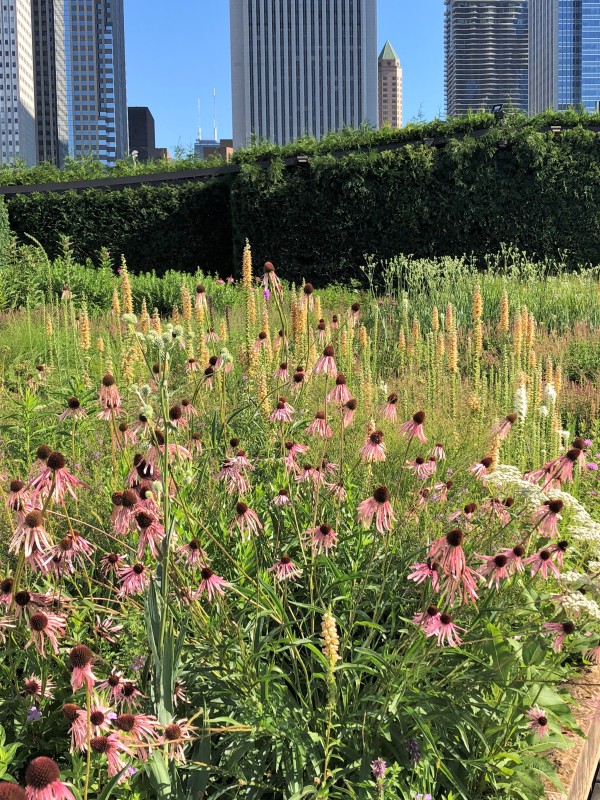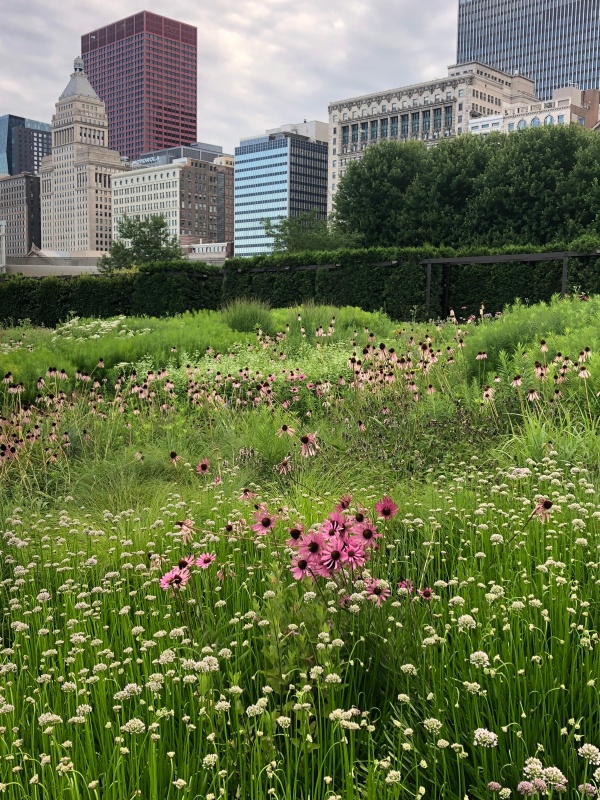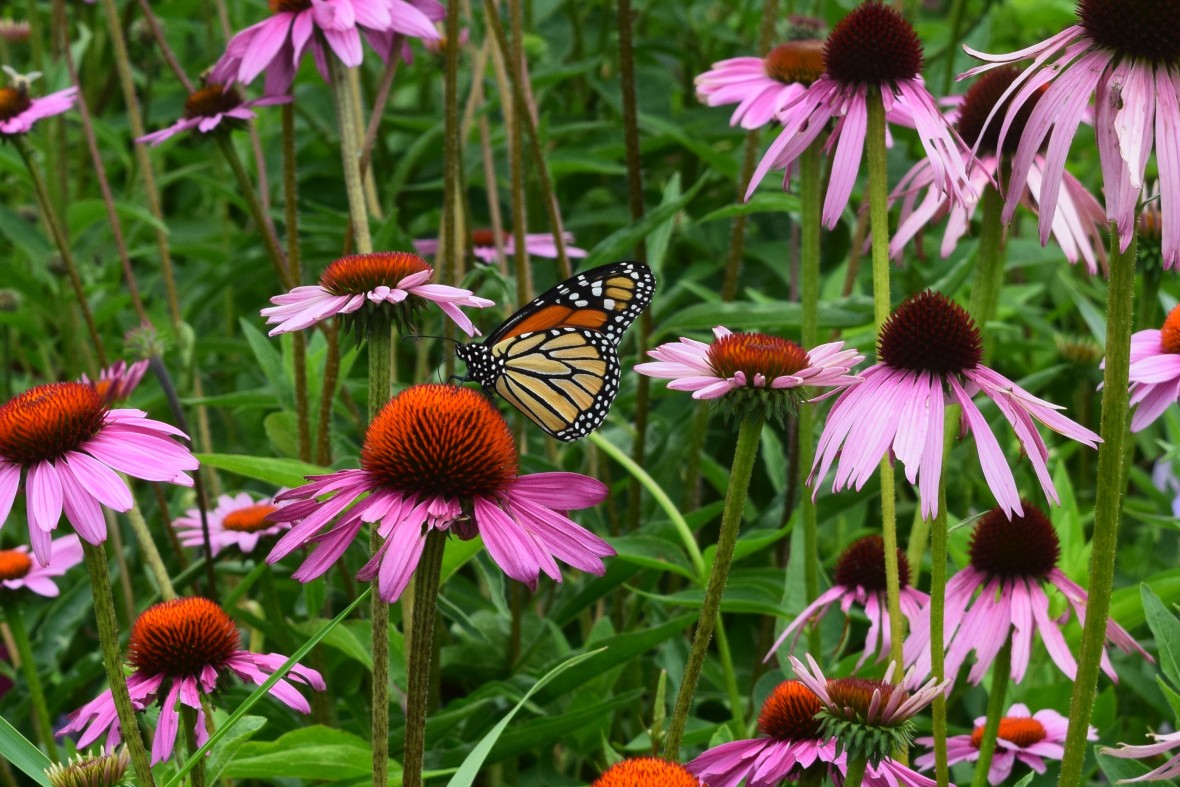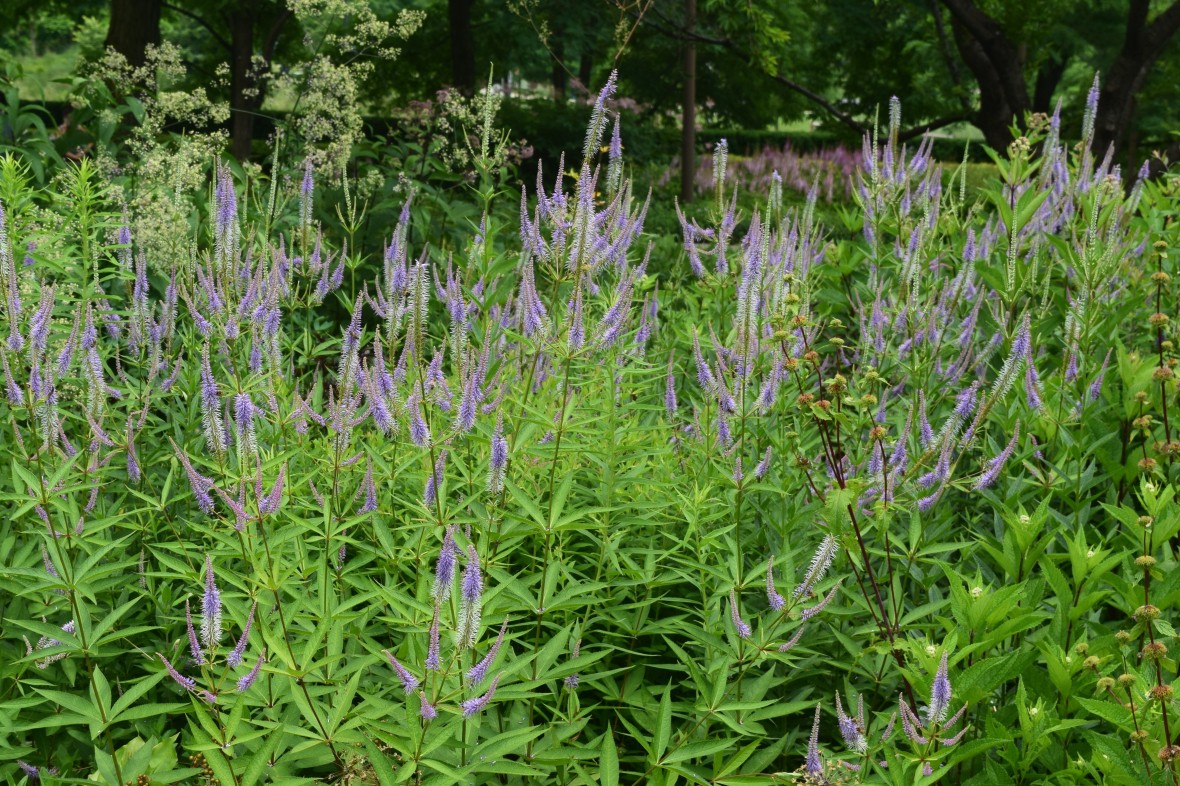July Stars of the Lurie Garden (2018)
There are certain plants that really define a garden at a given point in the season. This is certainly true of the Lurie Garden in July.

To my mind, these are plants that are beautiful individually, but that change the whole feel of a garden when they work together in big groups.

For example, Purple Coneflowers (Echinacea purpurea) and their close relatives really help make this a vibrant place at this point in the year. At the Lurie Garden there are a variety of species and cultivars, notably Pale Purple Coneflower (E. pallida), Tennessee Coneflower (E. tennesseensis) and Wavyleaf Coneflower (E. simulata), along with E. purpurea.

Even a small clump of Echinaceas stand out. Here they are surrounded by Alliums not quite ready to bloom.

Echinaceas are one of the best plants out there for wildlife, as these bees will attest.

As will this Monarch Butterfly. Butterflies seem unusually plentiful this year at the garden.

One reason, no doubt, is the presence of lots of Common Milkweed (Asclepias syriaca). This is an aggressive plant, and it has been spreading itself energetically around the garden. But it is also a beautiful flower with a heavenly fragrance, reminiscent of honey. There is one particular corner in the Light Plate with a very large clump of Milkweed, and I cannot pass by without stopping to take in the scent. Fortunately, there are several less aggressive species of this genus.

Another plant that grabs my attention at Lurie Garden in July is Rusty Foxglove (Digitalis ferruginea).

The combination of Rusty Foxglove with white and purple Blazingstar (Liatris spicata) is just brilliant. Both stand at attention but the colors and flower textures contrast with each other so beautifully.

Then there’s Allium ‘Summer Beauty’ (Allium lusitanicum), truly a fantastic plant when planted in large drifts. I love that mass of lavender blue, which is always humming with bees.

There are many plants that may not be stars, but still are playing supporting roles at the Lurie Garden right now. There are a variety of Monardas in the Dark Plate providing some additional color – mainly purple and pink. Not sure about the one above – looks like ‘Purple Rooster’ but maybe it’s ‘Scorpion’.

There’s just one clump of this Fleabane (Inula magnifica), but it definitely catches my attention. It’s intriguing, but I’m glad that it is used sparingly.

A massive Queen of the Prairie in the Dark Plate (Filipendula rubra).

A few nice drifts of Culver’s Root ‘Temptation’ (Veronicastrum virginicum).

Wild Petunia (Ruellia humilis) does a good job of mixing in with short grasses and keeping the ground covered.

This is another plant combination I love: Globe Thistle ‘Big Blue’ (Echinops bannaticus) with Balloon Flower (Platycodon grandiflorus).

Not a plant, but certainly another star of the garden: the stepped pools, which are working again after a long struggle with underground pipes. On a hot July day, people just cannot resist taking off their shoes and socks and putting their feet in the water.





Rusty foxglove seems to be gaining popularity. It seems like it was uncommon not too long ago, but is now seen ore often than the common pink and white type that naturalizes in moist areas.
It’s not common at all in the Midwest. Lurie Garden is the only place I’ve ever seen it.
I have never seen it, but have seen several pictures of it. I do not see the common foxglove anymore. It seems that people think that it is too common, so do not bother bragging about it anymore.
Thanks for this wonderful look at what’s flowering in the Lurie Garden right now. I always love your posts about that garden.
You’re welcome!
I agree with the last comment, I love your posts of the Lurie Gardens, and they are especially inspiring as we are thinking about new plantings. In the first few photos the plants seem to be reaching up to the buildings in the background. Very good to see more Monarch Butterflies in the Gardens this year.
It’s always so striking to see how the tall, vertical plants echo the tall buildings.
I love those tall balloon flowers. I have the short ones that while they have those beautiful blue flowers they aren’t nearly as dramatic as the tall ones. I have a white Culver’s Root blooming in the garden. I am glad that you posted about the purple one. I had forgotten the name of the Culver’s Root. Maybe now it will stay in my head.
I planted some white Culver’s Root this year but I don’t expect it to bloom this year.
I love coneflowers, and what a happy sight to see them scattered throughout this garden. And all that milkweed–wow! I have noticed more butterflies the past two weeks, as well, which is encouraging. I really need to make a trip to the Lurie at the height of summer.
I haven’t grown Echinaceas for years because of problems with aster yellows. Maybe I should try them again.
I always enjoy your blogs on Lurie Garden – this one was particularly good. Thanks.
Thank you!
What a fantastic place! I am always so taken by the drift off flowers against the cityscape. Wonderful that they grow milkweed for the monarchs.
It seems that Common Milkweed is becoming an accepted plant for urban naturalistic landscapes. I think that is pretty new.
And a very good thing.
I love your Lurie Garden updates! It is fantastic : ) I put in little pollinator cafes, this is a super center for pollinators.
Thanks. I also aim to set up a pollinator cafe or two, but as you say Lurie is almost in a class by itself.
That foxglove looks good in a number of combos. Think I need to find it for my garden. I don’t think the Lurie Garden ever looks better than in high summer.
I’ve never seen Rusty Foxglove in a local nursery or garden center. I’m not sure where to find it.
That’s such a beautiful place at any time of year!
I like that fleabane. I’ve never seen it. I haven’t seen a coneflower yet this year either but it shouldn’t be long.
The Fleabane sure has character.
Beautiful gardens. Love the blue of the globe thistle.
So do I!
It looks as though there might be standing winecup mixed in with the monarda. I sometimes see it mixed with Indian paintbrush and bluebonnets in our hill country. We also have winecup, but it’s a different species. I saw the tall, standing winecup in the Ouachita Mountains of Arkansas, too.
I was astonished to see white Liatris. I’ve only ever seen lavender or purple (or sometimes pinkish.) I see there are white ones that are cultivars. Is that the case here?
Yes, I think those are Winecups.
Hello Jason, it’s all very subtle planting apart from the “punctuation” plants that look as though they’ve appeared by accident. I prefer the common foxglove over the rusty one but I love the Liatris and Echinops. Those two are on the list for the garden. We’ve tried Liatris before in a previous garden without success so I’m hoping for better luck this time.
Just visited a restored prairie that had just loads of Liatris. The conditions they prefer vary widely depending on the species.
So many delightful combinations, I especially like the tall ones. The Echinacea is gorgeous. I would certainly dip my feet in the water!xxx
I was tempted, but I had to get back to the office!